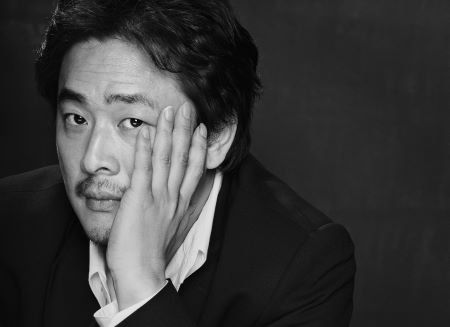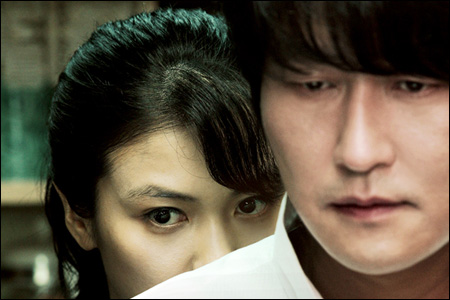
by Lisa Morton
I’m still not quite sure what to make of Park Chan-wook’s THIRST.
It’s certainly not that I mind that Park, known in the past for his non-supernatural thrillers, has made a real, honest-to-God vampire film. Nor do I mind that THIRST isn’t just a horror film, but mixes genres in a crazy quilt approach that throws in black comedy, love story, and philosophical art film; after all, Park’s last movie, the delightfully nutty I’M A CYBORG, BUT THAT’S OKAY crossed science fiction, romantic comedy, and action film in its story of two mentally disturbed and incarcerated young people who fall in love (while experiencing a variety of delusions).
But I think what bothers me about THIRST is that it somehow feels like the first film in which Park has become seriously aware of his own reputation.
In case you’ve been living in a cave for the last few years, Park’s OLDBOY came exploding out of his native South Korea a few years ago to become a global sensation. The thriller, starring Choi Min-sik as a man inexplicably held in captivity for 15 years, and then just as inexplicably released one day, captured legions of fans for Park around the world. It became equally famed for its sheer outrageousness (especially a scene in which Choi Min-sik clearly eats a live octopus), and its twist ending. A few already knew Park as the director of two excellent earlier thrillers, the small, tense JOINT SECURITY AREA (2000), about an incident along the South Korean/North Korean border, and the more flamboyant SYMPATHY FOR MR. VENGEANCE (2002), which inaugurated his “Vengeance” trilogy, with OLDBOY serving as Part 2 and SYMPATHY FOR LADY VENGEANCE (2005) completing the series. LADY VENGEANCE happens to be my personal favorite of Park’s films; it features brilliant performances from both Lee Yeong-ae in the title role, as a woman imprisoned for killing her child who plots a devious revenge on the real murderer, and again, Choi Min-sik as the school teacher-cum-child killer. The film is a brilliantly constructed series of set pieces, complete with loads of inverted morality (is our heroine wrong in her pursuit of vengeance?), and some stunning action scenes, especially one in which the Lady is forced to pursue two bad guys because her exquisite custom-made gun is only accurate at a few feet.

After making LADY VENGEANCE, Park gave us a tiny taste of vampirism in his short “Cut”, which appeared in the anthology film THREE: EXTREMES. Although the main thrust of “Cut” is another vengeance story involving a movie director, the piece opens with a strange and funny scene of a cinematic vampire (played with delicious over-the-top gusto by A TALE OF TWO SISTERS’ stepmother, Yum Jung-Ah) experiencing a gruesome form of heartburn as a result of her last victim.
If “Cut” suggested that Park’s take on vampirism would be less than completely serious, it certainly couldn’t have predicted the odd mishmash that is THIRST.
The main vampire in THIRST is a troubled priest, Sang-hyun (played by the gifted and versatile Song Kang-ho, last seen as “Blondie” in THE HOST and the “Weird” part of Kim Ji-woon’s THE GOOD, THE BAD, WEIRD); Sang-hyun beats himself to banish sexual thoughts, and eventually volunteers for a potentially-lethal medical study. Inoculated with a deadly virus, Sang-hyun survives, but it isn’t until he returns to his parish that he discovers he’s become a vampire. The vampirism creates more than a desire for blood in the reborn priest, and he becomes involved with Tae-ju (Kim Ok-bin), a lonely young orphan who is treated like a dog by her adoptive mother (now her mother-in-law) and her husband, the boorish Kang-woo (played by Park regular Shin Ha-kyun). A particularly twisted triangle (involving some of the squirmiest sex scenes ever put on film) ends up leading to murder, a haunting, and vampiric mass killings.

It’s tempting to suggest that the biggest problem with THIRST is the literal interpretation of vampirism as metaphor for Catholic guilt. That element has been present in stories of the undead ever since Stoker recreated bloodsucker mythology in DRACULA, bringing in Victorian sexual repression and the benevolent power of Christian faith; to make that the text itself, rather than the subtext, almost seems obvious. And yet it’s also undeniably clever, to finally move the vampire’s secret meaning into the light, by making the monster into a priest who is overcome by sexual and murderous desires.
What’s most troubling about THIRST, though, is its odd pace and occasionally static compositions. It’s the first time that Park has made a movie that feels like an arthouse film; the editing is choppy, with vignettes that begin and end in fade-ins and fade-outs, and the production design becomes more deliberately artificial as the film progresses (who lights their house with fluorescent bulbs hung from the ceiling at angles, dangling only by their wires?). OLDBOY was deservedly famous for its single-take long fistfight scene, a fluid masterpiece of direction that sustained tremendous energy and motion without any cuts; but in THIRST the action scenes feel artificial and less original. One scene, in which Sang-hyun leaps from the top of a skyscraper while carrying a gleeful Tae-ju, has some of the sheer filmmaking joy that has permeated Park’s earlier films, but THIRST could have used more of that propulsive motion.
THIRST is also a surprise on the acting front. Song Kang-ho, usually the most unpredictable of performers, downplays Sang-hyun to the point of making him deliberately bland; fortunately, though, young Kim Ok-bin is more than happy to step in and steal the film, with a passionate, lunatic performance that gets more demented as the film progresses. She’s charismatic and compelling as the girl who undergoes her own strange rebirth, and her performance is probably the single best thing about THIRST.

As a vampire film, THIRST eschews the Chinese “hopping vampires” and instead hews to most of the Western traditions – these vamps suck blood, are immensely strong, and fry in sunlight – but one of the tropes it lacks is a vampire hunter. The film’s heroes are also its villains, and it’s fairly clear from the beginning (no spoiler alert needed here) that Sang-hyun’s guilt will finally damn him for good. While the philosophical aspects of this are interesting, it does create a curious lack of impetus, especially in the second half of THIRST – there’s no exterior conflict to propel the plot, no forces of good closing in, no exciting chase or fight.
I suspect that, some years down the road, THIRST will be more of a curiosity in Park’s resume than a much-lauded and studied work, like OLDBOY or LADY VENGEANCE. It will be interesting to see what direction his sensibilities will head in after this – will he continue down the path of the more formalized art film, or head into entirely new territory? We can only hope for the latter.
THIRST Official Website
--Lisa Morton
NOTE: Remember, you can catch all past of Lisa's THE EAST IS RED articles at http://www.lisamorton.com/
